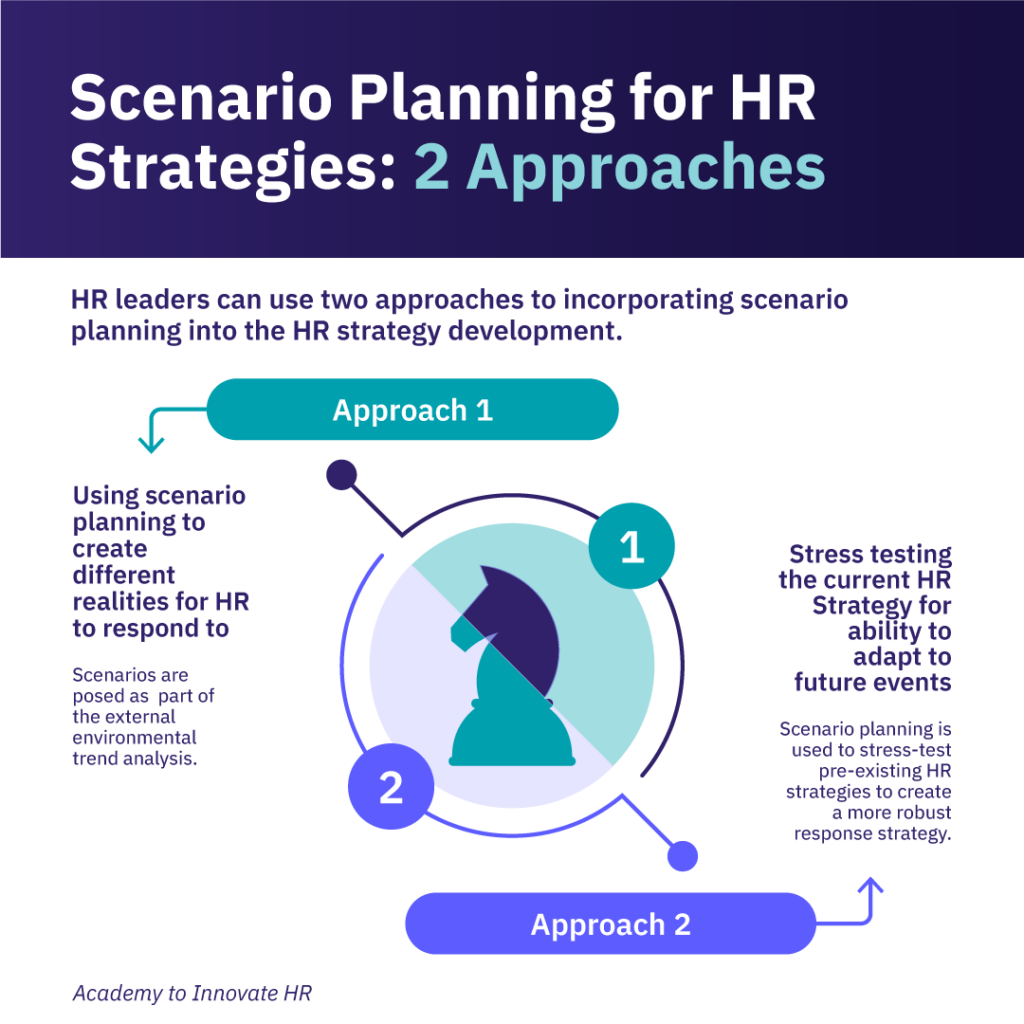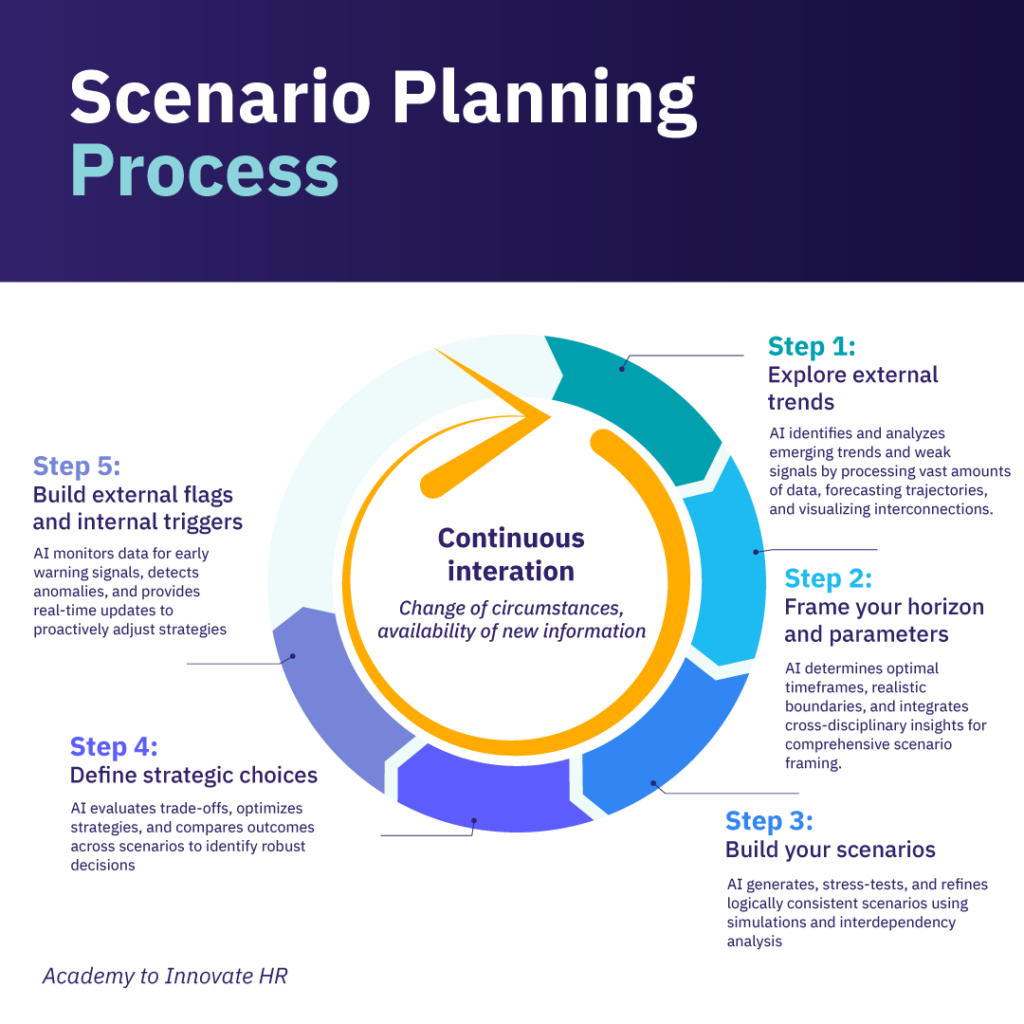Most HR strategies aren’t adaptable enough to keep up with today’s workplace – yet HR leaders tend to stick to their strategy, defending their relevance. Challenges like AI, political instability, and shifting labor markets demand more flexible approaches.
Our research examined how leading companies develop their HR strategies. These efforts typically bring order to chaos by establishing clear principles for decision-making. However, we found the strategy process is often flawed. HR strategies often lag behind business goals or are expected to be finalized before business strategies are complete.
It’s not just about fixing the process. The fast-changing external environment makes traditional strategies outdated.
Our HR Trends 2025 report introduced the concept of “Looming Organizational Anxiety,” highlighting how constant uncertainty creates new challenges. A scenario-focused approach to HR planning can better prepare professionals to adapt. And AI offers even more opportunities. It makes scenario planning practical and helps HR leaders craft proactive, resilient strategies, even with limited resources.
What is strategic scenario planning in HR?
Scenario planning is about envisioning possible future events and preparing possible responses in case they happen. This approach has been widely used, with companies like Shell famously applying it to plan for potential oil crises. Over the years, many other organizations have also relied on scenario planning.
For example, climate crises have forced organizations to relocate people, introduce travel benefits for those in affected areas, or rethink workplace strategies. Using scenarios, HR could have been better prepared for these challenges, with well-thought-out responses already tested and monitored.
The benefits of scenario planning
Scenario planning brings the following benefits to HR:
- Future-proofing workforce needs: Anticipates talent requirements, skills gaps, and workforce dynamics under various future scenarios, ensuring alignment with organizational goals.
- Enhancing agility and risk mitigation: Enables flexible strategies to address disruptions like technological advances, economic shifts, or workforce shortages, reducing organizational risks.
- Adapting to technological and cultural shifts: Prepares HR for integrating AI, automation, and evolving employee expectations, including remote work, diversity, and inclusion.
- Improving employee experience and retention: Designs proactive policies for engagement, wellbeing, and inclusion tailored to potential changes in workforce composition and expectations.
- Strengthening organizational resilience: Supports leadership succession, crisis management, and collaboration across functions to prepare a workforce for uncertainty.
How to incorporate strategic scenario planning into the HR strategy process
Scenario planning can be incorporated into the HR strategy in two ways:
Technique 1: Using scenario planning to prepare HR for different outcomes
Scenario planning can be a key part of analyzing external environmental trends. Most HR strategy processes follow these steps:
- Step 1: Analyze the external environment to understand trends affecting the business
- Step 2: Conduct an as-is analysis of the organization to identify strengths and threats
- Step 3: Interpret the business strategy and focus on identifying priorities and strategic choices
- Step 4: Align HR priorities with the business strategy
- Step 5: Develop HR objectives and key initiatives
- Step 6: Create an execution roadmap and determine resource needs.
The external analysis should go beyond current trends and include a broader look at future scenarios to make scenario planning more effective. The difference between these approaches is explained below.
Traditional approach
Organizations leverage frameworks like the PESTLE analysis to assess their external environment and inform strategic decisions:
- Political: A newly elected political party plans to introduce trade tariffs and labor legislation over the next two years, requiring HR to adapt policies and ensure compliance.
- Economic: Rising exchange rates are set to increase manufacturing costs and squeeze profitability, pushing HR to explore cost-efficient workforce strategies.
- Social: Local youth unemployment urges organizations to invest in job creation and early-career development programs.
- Technological: Advances in sustainable packaging demand automation, prompting HR to reskill employees and attract talent skilled in automation technologies.
- Legal: New patent legislation will influence governance, necessitating HR-led compliance training and adjustments to IP-related roles.
- Environmental: Climate change’s impact on supply chains requires HR to support sustainability initiatives and address evolving workforce needs.
These insights drive HR’s strategic response, shaping workforce planning and capability building to align with emerging trends.
Scenario-focused approach
PESTLE analysis provides valuable insights, and integrating a scenario-based approach deepens strategic preparation. This approach asks forward-looking questions to develop actionable strategies based on the insights gathered through the PESTLE analysis:
- What actions should we take if trade tariffs are implemented?
- How do we adapt if manufacturing costs become unsustainable?
- How can we create meaningful job opportunities?
- What changes are needed if new legislation is enacted?
- How do we prepare for climate change’s impact?
By building on these questions, the analysis transitions from static input to dynamic scenario planning, producing tailored responses for multiple futures.
For example:
- Scenario A: Trade tariffs and labor legislation are enforced, requiring workforce restructuring.
- Scenario B: Manufacturing costs rise sharply, necessitating automation and global sourcing adjustments.
- Scenario C: Climate change disrupts supply chains, driving a shift toward local suppliers and sustainability-focused roles.
Incorporating scenario planning at the start of the strategy process allows organizations to become more adaptable, resilient, and prepared in their strategic responses, broadening the scope and depth of their strategy. Remember, the goal is not to fall into analysis paralysis but to foster the ability to ask “What if?” questions so that you can develop a range of potential responses that the strategy can accommodate.
After the planning phase, the second approach uses scenario planning as a key tool to review and test the adaptability of current HR strategies.

Technique 2: Stress testing the HR strategy for adaptability to future events
In the second approach, scenario planning is used to stress-test existing HR strategies, making them more resilient and adaptable. By integrating strategic scenario planning into the strategic review process, HR leaders can pinpoint areas where the strategy needs to adapt to evolving external circumstances.
This approach helps leaders avoid rigid thinking, encouraging them to explore new possibilities beyond their immediate strategic focus and prepare for the future.
Practical example
Consider Company Y’s HR strategy, which focuses on these objectives:
- Objective 1: Driving digital transformation
- Objective 2: Building a talent brand to attract and retain employees
- Objective 3: Enabling a leadership community that drives business sustainability
- Objective 4: Fostering an inclusive and diverse workplace
- Objective 5: Streamlining HR services to reduce costs.
Using a process similar to defining scenarios in the first approach, Company Y can stress-test its HR strategy against different future scenarios to ensure it holds up under various conditions.
Trade tariffs and labor legislation are enforced, requiring workforce restructuring.
Manufacturing costs rise sharply, necessitating automation and global sourcing adjustments.
Climate change disrupts supply chains, driving a shift toward local suppliers and sustainability-focused roles
How does the HR strategy response align with each of the stated objectives:
Digital transformation: Automation becomes critical to offset higher operational costs. HR must accelerate the digital upskilling of employees and embed technology into HR processes to improve efficiency.
Digital transformation: Expand automation in manufacturing while developing HR’s predictive analytics capabilities to align workforce needs with cost-saving initiatives.
Digital transformation: Introduce AI-driven supply chain management tools and sustainability-focused employee training. HR would drive green technology adoption as part of digital transformation.
Talent brand: Position the organization as resilient and future-ready, leveraging the ability to navigate new trade conditions as a competitive advantage to attract talent.
Talent brand: Reinforce employer branding by emphasizing the organization’s commitment to innovation and resilience in challenging times, ensuring candidates see the value in joining a forward-thinking organization.
Talent brand: Enhance the brand’s commitment to environmental sustainability, appealing to candidates who prioritize purpose-driven work.
Leadership community: Equip leaders with change management skills to adapt to regulatory complexities and engage the workforce through uncertain times.
Leadership community: Prepare leaders to manage workforce restructuring compassionately and ensure transparent communication during operational changes.
Leadership community: Develop leaders’ sustainability and crisis management capabilities to drive long-term business viability and environmental stewardship.
Inclusion & Diversity: Use new regulations as an opportunity to create equitable hiring practices and emphasize local job creation for underrepresented groups.
Inclusion & Diversity: Prioritize redeployment and retraining programs for displaced employees to retain a diverse workforce.
Inclusion & Diversity: Ensure inclusive decision-making in sustainability efforts, involving diverse perspectives to innovate solutions for environmental challenges
Optimize HR services: Streamline compliance processes and adopt tech-enabled solutions to reduce manual effort and lower costs.
Optimize HR services: Reengineer HC services to provide greater scalability and flexibility, ensuring reduced administrative costs without compromising employee experience.
Optimize HR services: Embed sustainability into HR service delivery, such as using eco-friendly practices in recruitment and operations while focusing on cost-efficiency.
Importantly, in this approach, scenario planning doesn’t change the strategy’s objectives but rather focuses on how the objectives will be achieved and approached, depending on changes in the environment.
For many HR leaders, scenario planning has traditionally been out of reach due to a lack of technical expertise, limited time, and the inability to work with the extensive market data required for practical analysis. Fortunately, AI transforms this dynamic by making scenario planning more accessible, efficient, and user-friendly.

How AI can be used in strategic scenario planning
For many, the scenario planning process can feel overwhelming, especially when resources and expertise for building robust scenarios are limited. AI offers a transformative solution, simplifying the process by leveraging advanced analytics and automation to generate actionable insights.
Here’s how AI can support and enhance the scenario planning process:
1. Data analysis
AI processes and analyzes vast amounts of structured and unstructured data from diverse sources, such as industry reports, economic forecasts, social media, and policy updates.
How it helps: Tools like Natural Language Processing (NLP) extract relevant trends and insights, while predictive analytics models forecast future developments, such as changes in labor markets or economic conditions.
2. Scenario generation
AI creates dynamic simulations and “what-if” analyses, modeling how different external factors might interact to shape the future.
How it helps: Scenario generation allows organizations to test multiple scenarios, such as economic disruptions or regulatory changes, and visualize their impact on HR strategies, including workforce planning and digital transformation.
3. Decision support
AI translates scenario insights into actionable recommendations, helping organizations prioritize responses.
How it helps: By assessing potential outcomes, AI provides prescriptive guidance on initiatives like reskilling programs, compliance adjustments, or recruitment focus shifts, enabling HR teams to address challenges proactively.
4. Visualization
AI-powered tools present complex data and scenarios through intuitive dashboards and visualizations, making them easier to interpret.
How it helps: Stakeholders can quickly understand potential impacts and trade-offs, fostering alignment and informed team decision-making.
5. Real-time monitoring
AI keeps scenarios up-to-date by continuously incorporating new data and identifying emerging risks or opportunities.
How it helps: This real-time adaptability ensures that strategies remain relevant and aligned with rapidly changing external conditions.
Integrating AI into the scenario planning process
In an earlier article, we introduced the scenario planning process. Here, we explore how AI can be seamlessly integrated into each stage of this five-step approach. Below, we outline how AI can enhance each step of the process in practical and impactful ways:
Step 1: Exploring external trends: AI identifies and analyzes emerging trends and weak signals by processing vast amounts of data, forecasting trajectories, and visualizing interconnections.
Step 2: Framing horizon and parameters: AI determines optimal timeframes, realistic boundaries, and integrates cross-disciplinary insights for comprehensive scenario framing.
Step 3: Building scenarios: AI generates, stress-tests, and refines logically consistent scenarios using simulations and interdependency analysis.
Step 4: Defining strategic choices: AI evaluates trade-offs, optimizes strategies, and compares outcomes across scenarios to identify robust decisions.
Step 5: Building external flags and triggers: AI monitors data for early warning signals, detects anomalies, and provides real-time updates to proactively adjust strategies.
Getting started
Scenario planning empowers HR leaders to create more adaptable strategies by developing robust new approaches or stress-testing existing strategic objectives. With the integration of AI, scenario planning can and should become a fundamental tool in every HR leader’s strategic arsenal. Leveraging AI ensures that the HR strategy process evolves to meet the demands of an ever-changing world, elevating its relevance and impact.
How we can help
We help to empower you and your teams to develop and implement HR strategies that drive business impact. Our comprehensive programs, like the HR Business Partner 2.0 Certificate Program, focus on aligning HR initiatives with organizational goals, ensuring that HR functions contribute directly to company success.
Our Certificate Programs emphasize data-driven decision-making, equipping professionals with the skills to analyze workforce data, identify trends, and make informed choices that enhance performance. By integrating strategic alignment and analytics into the training, we enable HR teams to proactively address challenges and implement effective strategies.







